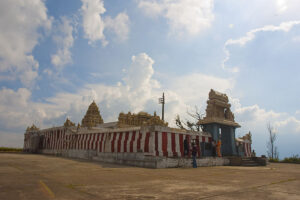
Himavad Gopalaswamy Betta, is a hill (betta in Kannada) located in the Chamarajanagar district of the state of Karnataka, at a height of 1450m and is extensively wooded. It is also the highest peak in the Bandipur National Park. It lies in the core area of the Bandipur National Park and is frequented by wild life including elephants. Dense fog predominates and covers the hills round the year and thus gets the prefix Himavad in the language of Kannada) and the temple of Venugopalaswamy (Lord Krishna) gives the full name of Himavad Gopalaswamy Betta. Himavad Goplaswamy Betta is also known as “Karnataka’s Kashmir”, and is situated 2800 feet above sea level.
Its geographic coordinates are: Latitude 12.97°Ne and longitude 77.56°E.
As the name of the hill goes, the temple on the hill is dedicated to Lord Gopala swamy, which is one of the many names of Lord Krishna. The temple is some 700 years old. The history of the origin is a bit hazy and there are a few conflicting views on who built the temple. It is generally attributed to the local king Chola Ballala of Terakanambi.
The garbha griha contains an idol of Krishna holding a flute under a tree. Krishna is flanked by his friends and the posture is that of a dance with the left big toe resting on the right one. The panel also features several characters and icons from Krishna’s avatar.
Lord Gopalaswamy’s idol is flanked by his consorts, Rukmini and Satyabhama. Cows and cowherds are featured towards the right side of the panel.
There are 77 theerthas or springs along the slopes of the hills within 25 km radius of the temple. The saying is that the crows, which took bath in these springs, turned into swans and hence there are no crows in Bandipur. About a kilometer away from the temple is a rock, it is believed that those who consume water from the spring on an empty stomach and visit the gopala swamy betta temple Mysore to seek the Lord’s blessings will very soon be blessed with children.
This water is also believed to have the goodness of 28 medicinal roots and minerals dissolved in it naturally. A lake, a few hundred feet below the peak, serves as the local watering hole for wildlife.
Legend says that sage Agastya, performed intense penance and as a result lord Vishnu blessed this place and promised to reside here. As this was a place of worship and penance, it used to be called as ‘Hamsatheertha’, which means the lake of swans in Sanskrit. Swan acquires a mythological significance in Hinduism, symbolizing knowledge, tranquility and salvation.
Source:
http://www.himavadgopalaswamy.org.in/
https://en.wikipedia.org/wiki/Gopalaswamy_Hills
http://www.mysorepraje.com/index.php/mysore-excursion/11-himavad-gopalaswamy-betta
http://www.mysorepraje.com/index.php/mysore-excursion/11-himavad-gopalaswamy-betta
http://static.panoramio.com/photos/large/38728895.jpg


